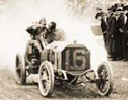There's Hope Yet For Modern Racing
By
4/24/05
I don't believe in the good old days. Never have. Never will.
For starters, how do you define the good old days? What I consider to be the good old days are the years that my parents lament while they look back on their good old days, which of course are the years that causes their parents to look back on their good old days.
Either every era are the good old days, or none are. You can't have it both ways.
Secondly, we tend to romanticize our good old days, conveniently forgetting those items that weren't so good. For instance, I may look back at the racing era of the 60s and early 70s, and think that the cars were so much more interesting with exciting innovation, wild wings, bizarre looking bodies, and outrageous engine designs.
What I tend to blur out is the cars were horribly unsafe. Formula One alone average three driver fatalities a year. Per year! That would never be tolerated in today's risk averse society. Fire was a horrifying commonplace occurrence on the Indy car circuit. Fan safety, though better than the 50s, still had it's tragic moments.
No, my good old days weren't so good after all.
However, times do change. That is a fact. And sometimes, they change for the worse. One thing that modern day racing -- with all the advances in aerodynamics, downforce, and "dirty air" -- has caused is a lack of an actual race, where a pass is as likely to occur at a geekfest than on a race track.
Competition can be artificially instilled in racing, but then you lose the technological attraction to it. From a marketing standpoint, it has never worked. Sure, NASCAR is extremely successful with this technique, but NASCAR has never pretended to be anything but a low-tech hero-led racing series. But, that marketing slice isn't big enough for someone other than NASCAR.
The IRL's attempt to dumb down open wheel racing hasn't exactly caught people's attention, though there are certainly other issues that have prevented the IRL from succeeded in the racing marketplace.
NASCAR attempts to do to sports car racing what it did to stock car racing with the Grand-Am series. However, despite at times some pretty good racing, it takes place in front of dismal crowds. Sometimes, in front of literally nobody. More people show up at god-forsaken Nelson Ledges for a SCCA regional club race than at the Grand-Am event at Fontana.
Open wheel and sports car fans have always liked the tech as much as the people and the racing. Sometimes, to the detriment of competition. One of the classic good old days racing series is the original Can-Am. Let's face it, talk about a series that had no passing and hardly any competition. The only times the leaders appeared to be close was when teams agreed beforehand to allow certain cars to lead a race, before the dominant cars simply took over and pulled away near the end.
This weekend, I watched two races that restored my faith in the ability for a high tech racing series to also have competition. One race actually took place the week before, but I wasn't able to watch it on tape till today -- the American Le Mans event from Road Atlanta on April 17. The other race was today's San Marino Grand Prix.
The last half hour of the ALMS race featured a battle in the GT2 class that was as riveting as I've ever seen. The Panoz Esperante driven by Robin Liddell led a Porsche driven by Timo Bernhard. Lap after lap, these two drivers fought tooth and nail for the victory. And, they fought cleanly ... well, mostly. Though the Porsche was never able to make a successful pass, the feints, the dives, the attempted outbraking left one at the edge of their seat.
Meanwhile, the Panoz was performing the most subtle and nonaggressive blocking, the way blocking is supposed to be done, not seen for a long time. And when the Porsche did grab some space, the Panoz properly let him have it instead of bush league weaving back and forth. This resulted in some of the best outbraking and side-by-side action I've ever witnessed.
Ultimately, the Porsche got into the back of the Panoz, spinning the lead car around, and taking over first place. The Panoz quickly got going. Though I believe wholeheartedly Bernhard never meant to touch Liddell, being black flagged was the proper call by the officials. Whether you commit a foul on purpose or not, you have to pay the penalty. That's the way it works in sports.
It was also refreshing to see the sportsmanship displayed by Alex Job, the owner of the Porsche. Though he was obviously upset by the officials' call, he kept his emotions in check unlike most of the NASCAR participants, and graciously accepted the loss and congratulated the Panoz team.
A few hours after watching that tape, the F1 race came on. From start to finish this was a thrilling affair. Raikkonen and McLaren looked to finally be back as race winners only to have their car fail. Alonso took the lead as Button chased him down. Meanwhile, Michael Schumacher, stuck in the back this time because of a mistake in qualifying and not because the car let him down, was fighting his way back, including a jaw dropping move around Button. While all this was going on, a slew of take no prisoners slicing and dicing maneuvers took place for many of the other positions.
As the final tense pit stops played out, Schumacher found himself on the tail of Alonso. Then, we the fans were treated with a battle reminiscent of the great 1992 Senna-Mansell duel at Monaco or, dare I say, almost getting into the realm of the mythic-like 1979 Gilles Villeneuve-Arnoux battle at the French GP.
Just like in the ALMS race, the leader took subtle but fair blocking maneuvers while the trailing car looked for every possibility to get by. Brakes locked up, wheels nearly touched, track space was at a premium. All the while it was clean, it was fun, it was exciting, and racing fans around the world learned how long they could truly hold their breaths.
All this coming just two weeks after Champ Car put on an exciting and competitive Long Beach Grand Prix. As good luck will have it, all three of these events were shown on network TV in America. The ratings may not be all that great, but a lot more people watched, and hopefully will be telling their friends about what they saw, then if it was on cable.
Too often we are quick to criticize the present while we conveniently forget what we want of the past. Has top flight motor racing in the high tech series become boring, no passing affairs? Was it more exciting in the past? Or, perhaps, when one looks at racing from day one, it's merely a case of cycles, and racing today is just as good, or bad depending on your perspective, as it was when they were running the original Vanderbilt Cup events.
Judging from the past three weeks of action in arguably three of the most high-tech series in the world, maybe modern day racing is still an exciting venture. Perhaps one day, fans will look back at 2005 and marvel at the season.
Maybe there are the good old days. And those good old days are now.
Copyright © 2005 by Russell Jaslow and Deep Throttle. All Rights Reserved.
| 



